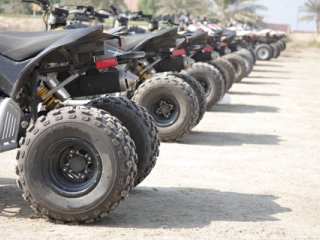 The landscape of America is as diverse as the people who live here. From New York City where cabs inundate traffic, to middle America where farmland dominates the view, and on westward to rugged mountain towns and open plains; which means that modes of transportation vary widely, too. Here in my sleepy Central California farm town, it’s not uncommon to get stuck behind a harvester, or wait on a back road for local kids on horses to cross. Which begs the question: if horses and tractors are allowed on the road near farms, should ATV’s be allowed on the road in locales where gravel is just as prominent as pavement?
The landscape of America is as diverse as the people who live here. From New York City where cabs inundate traffic, to middle America where farmland dominates the view, and on westward to rugged mountain towns and open plains; which means that modes of transportation vary widely, too. Here in my sleepy Central California farm town, it’s not uncommon to get stuck behind a harvester, or wait on a back road for local kids on horses to cross. Which begs the question: if horses and tractors are allowed on the road near farms, should ATV’s be allowed on the road in locales where gravel is just as prominent as pavement?
A growing number of local jurisdictions are beginning to say yes. The town of Riverdale, Utah, for one, recently voted to allow off highway vehicles to be driven on local city roads, citing that more and more residents are using ATV’s as a source of transportation around town, and for utilitarian purposes like snow plowing in the harsh winter months. Mind you, the population of Riverdale is only about 8,000 people, but they’re not the only ones who have given the green light to ATV’s on public roadways.
Although the restrictions, such as engine size, age of operator, vehicle weight and more vary by jurisdiction, as of a 2009 study by the Wisconsin Department of Transportation, eight states allowed some types of off highway vehicles to be operated on public roadways. These states included Indiana, Idaho, Kansas, Arizona, Minnesota, Montana, North Dakota and South Dakota. Meanwhile, additional states: Alaska, Missouri, Oklahoma, Nevada & West Virginia give ATV’s the right to operate under heavily restricted conditions on public roads; such as when a weather event makes the travel lanes impassible by motor vehicle.
However, take note that Utah, where that little town of Riverdale is located, isn’t mentioned in either group. That’s because nearly every State in the Union allows local municipalities to grant ATV riders the ability to operate on locally-run travel routes, such as city roads, road shoulders and right-of-ways.
All this talk of ATV’s on the roadway begs the question: is it safe? The majority of States and municipalities that have granted on-road rights to ATV users require a helmet and certain safety equipment, like tail lights and helmets. Thus, lawmakers expect that off highway vehicles brought onto small town city streets will be roadworthy and no more of a hazard to drivers than riding a motorcycle. However, many quad riders know that ATV’s don’t always handle the same on paved surfaces as they do on dirt roads, requiring drivers to be overtly aware of the conditions and their surroundings.
From my point of view, it’s reassuring that local lawmakers in some areas still trust their residents to be responsible citizens, and granting them access to public roads for a mode of transportation that is highly efficient for rural areas of this great country. And, really, what could be better incentive for getting your husband to run to the grocery store for you? “Honey, can you go get some milk? Just take the quad.”








